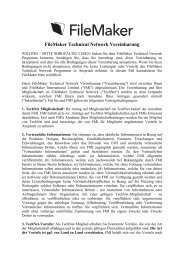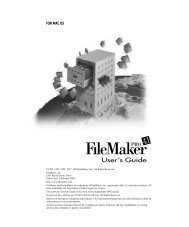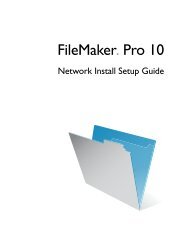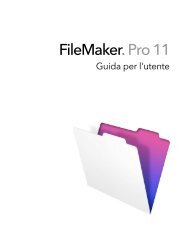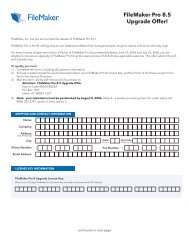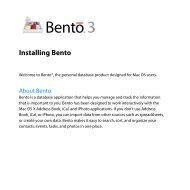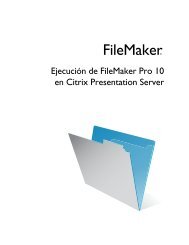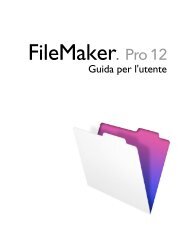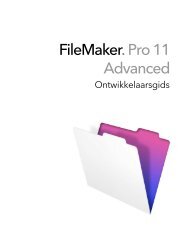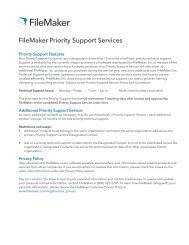FileMaker Security Guide
FileMaker Security Guide
FileMaker Security Guide
Create successful ePaper yourself
Turn your PDF publications into a flip-book with our unique Google optimized e-Paper software.
Chapter 3<br />
Build security into your solutions<br />
Developers and network administrators must assume the responsibility for managing security in the<br />
design and deployment of their database files, and for managing security on a routine basis.<br />
Restrict access with accounts and privilege sets<br />
The primary way to protect your files is to define accounts and privileges in <strong>FileMaker</strong> Pro. It’s a<br />
good practice to restrict access to every file, with an Admin password that only you know. This will<br />
protect files if other security measures have been bypassed.<br />
Important For information about how security settings in pre-7.0 databases convert to the current<br />
version of <strong>FileMaker</strong> Pro, see Converting <strong>FileMaker</strong> Databases from Previous Versions. See<br />
<strong>FileMaker</strong> Help for detailed, comprehensive information and step-by-step procedures about using<br />
account names, passwords, and privilege sets.<br />
Accounts authenticate users who are attempting to open a protected file.<br />
• Each account specifies an account name and (optimally) a password.<br />
• Each database file contains two predefined accounts: Admin and Guest. The Admin account,<br />
which should be renamed for better security, is assigned the Full Access privilege set. The Guest<br />
account, which cannot be renamed, permits users to open a file without providing an account<br />
name and password. By default, the Guest account is assigned the Read-Only Access privilege<br />
set, but you can assign a different privilege set in Accounts and Privileges.<br />
• For maximum security, create a unique account for each user.<br />
Privilege sets specify a level of access to a database file. Each database file contains three<br />
predefined privilege sets: Full Access, Data Entry Only, and Read-Only Access.<br />
• Each account is assigned one privilege set, which determines the level of access when someone<br />
opens a file using that account.<br />
• You can create privilege sets to limit database access, such as which layouts and menus are<br />
available and whether printing is permitted. Privilege sets can also restrict access to records or<br />
fields from particular tables within a file.<br />
Extended privileges determine the data sharing options that are permitted by a privilege set. You<br />
can enable privileges to access files shared with a <strong>FileMaker</strong> network, via Instant Web Publishing,<br />
Custom Web Publishing with XML or XSLT, from ODBC or JDBC clients, and <strong>FileMaker</strong> Mobile.<br />
All extended privileges are disabled by default.<br />
Important For maximum security, create accounts that require user names and passwords for all<br />
files. Take advantage of the security features by requiring users to change passwords after a<br />
specified duration and specifying a minimum character length for passwords.



